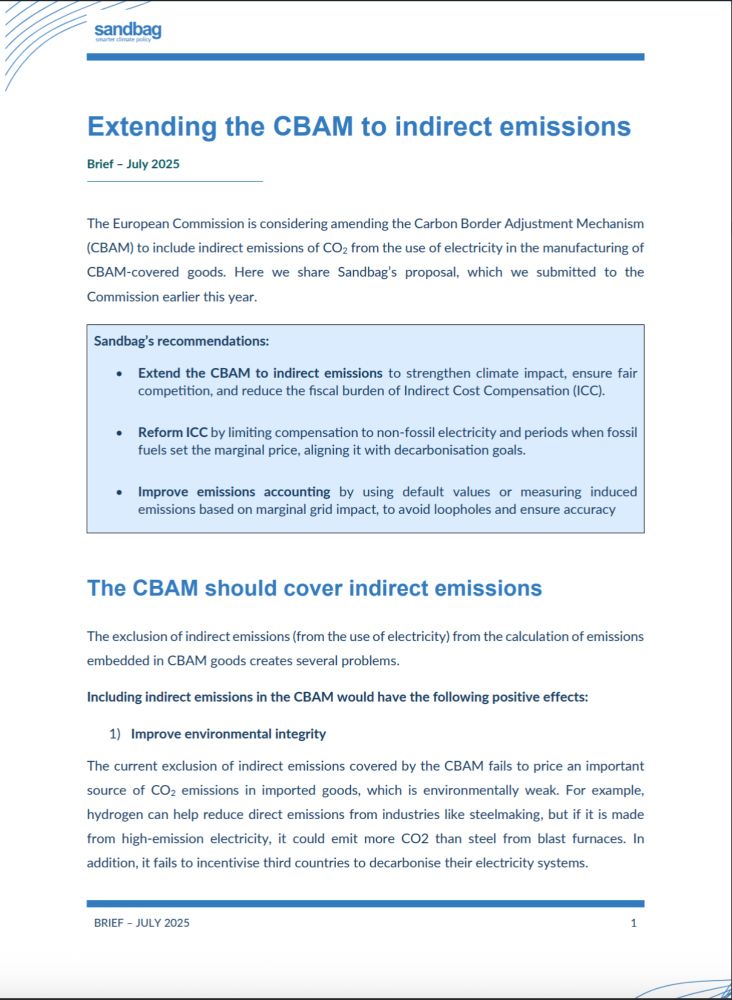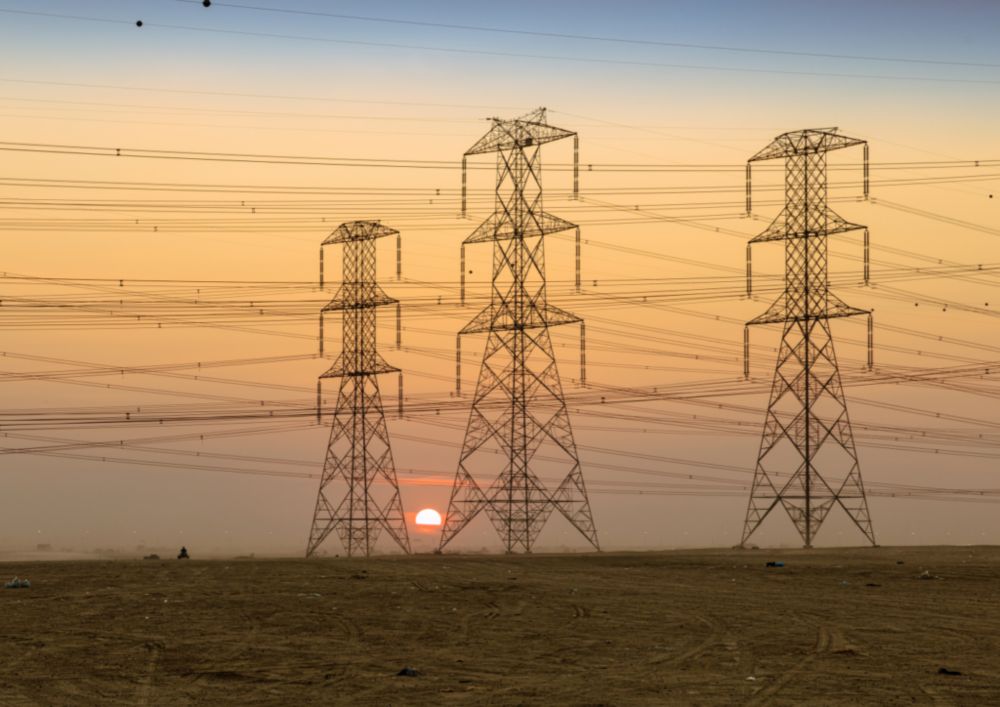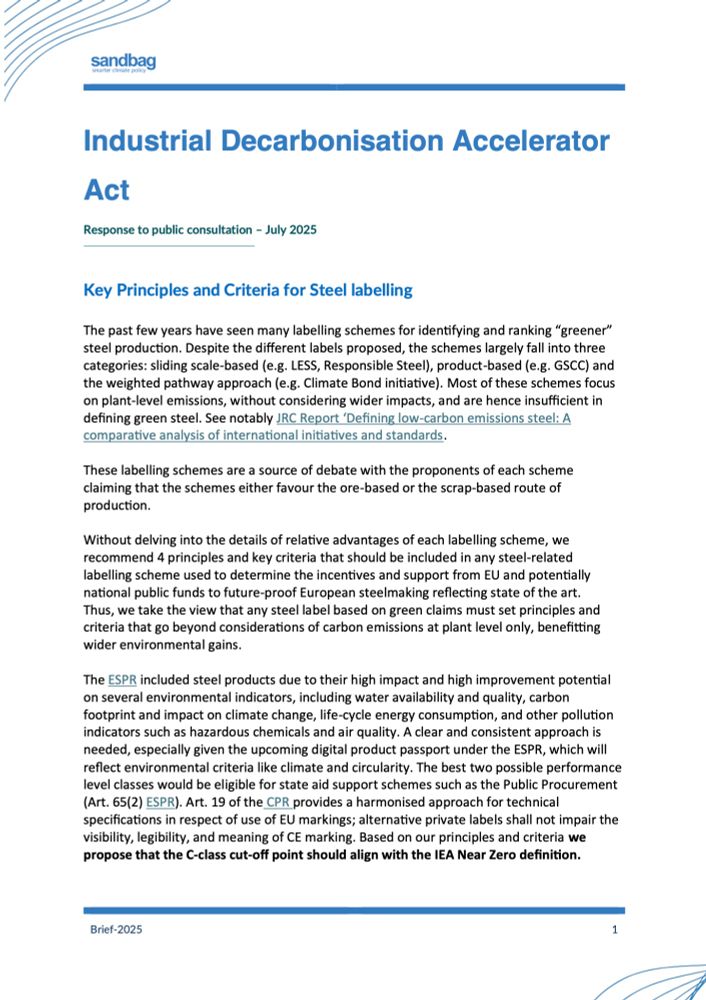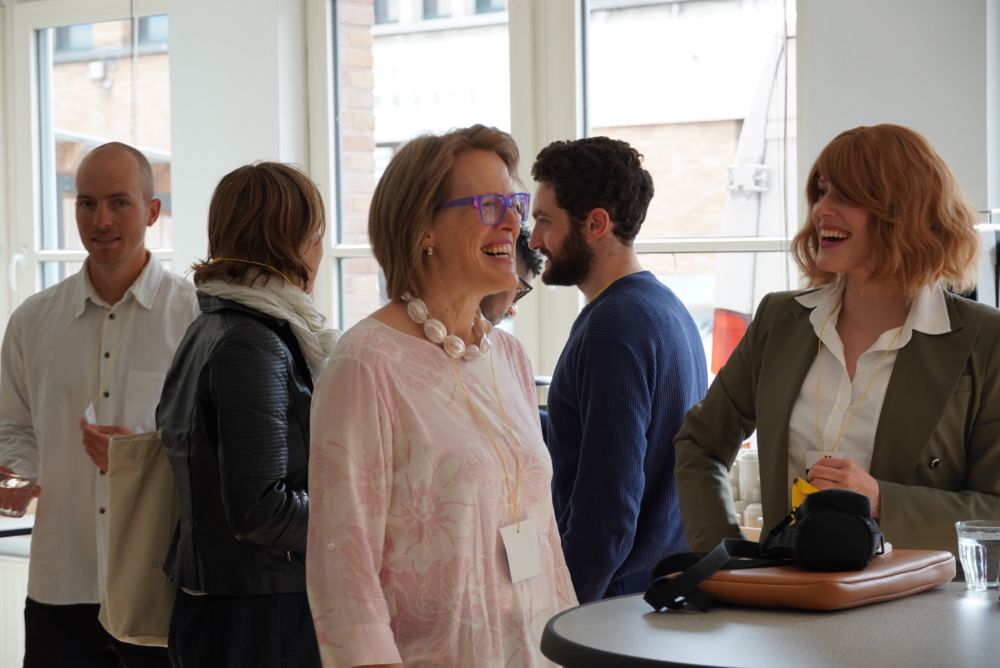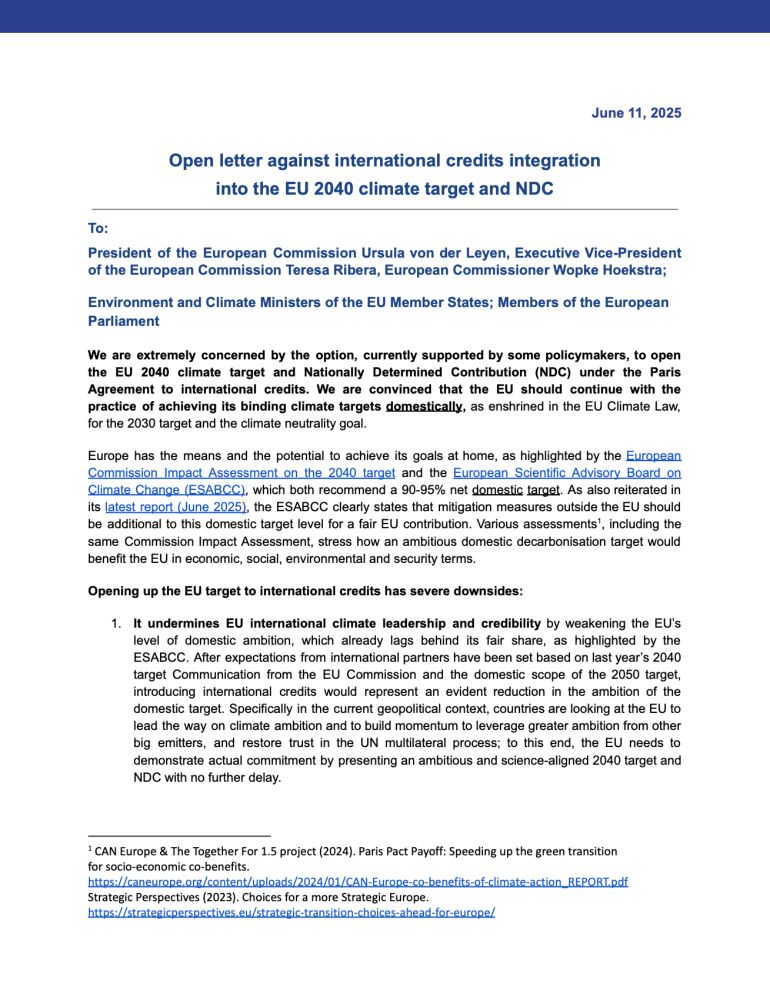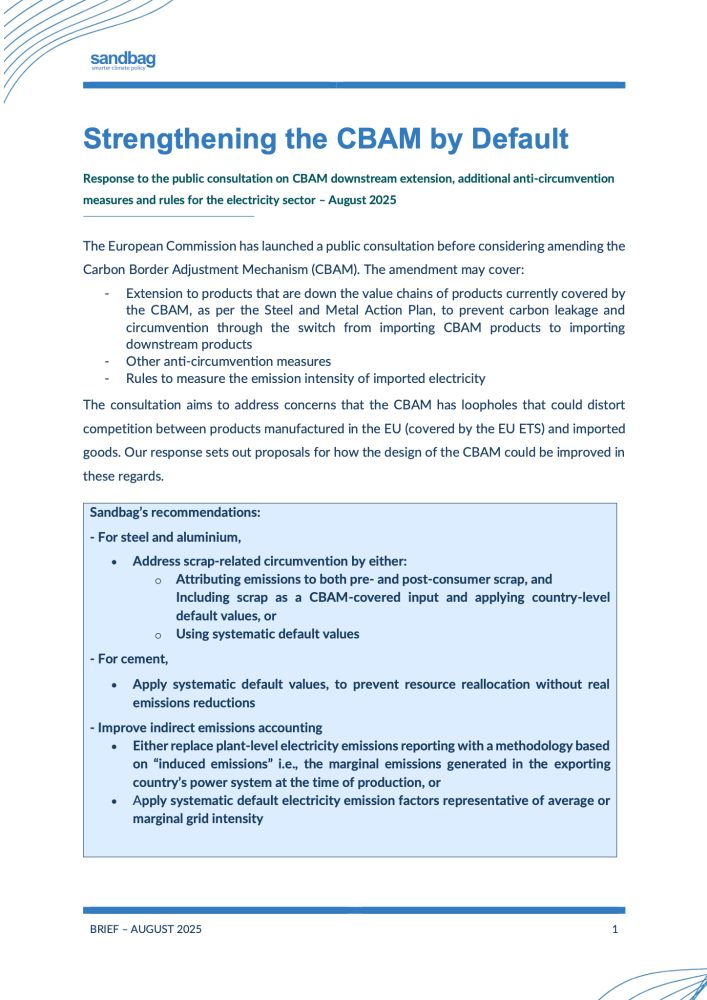
Strengthening the CBAM by Default – Sandbag’s August 2025 Brief
Sandbag’s August 2025 brief outlines how systematic default values can strengthen the CBAM—by tackling circumvention, enhancing fairness, and supporting cleaner trade.
The mutual benefits of systematic default values
✅ Close loopholes and prevents resource shuffling
✅ Cut admin burden and protect sensitive data
✅ Support systemic decarbonisation in exporting countries
📄 Read Sandbag's full brief:
sandbag.be/2025/08/06/s...
06.08.2025 11:16 — 👍 0 🔁 0 💬 0 📌 0
Electricity imports — capturing real impacts
Electricity import emissions come from grid impact, not just electricity source.
⚠️ Current rules miss this.
✅ Solution 1: Use “induced emissions” – reflect marginal fossil generation
✅ Solution 2: Apply systematic default values
06.08.2025 11:14 — 👍 0 🔁 0 💬 1 📌 0
Indirect emissions — closing the PPA loophole
⚠️ CBAM counts renewables as zero-emissions via PPA/direct link, but this can still trigger fossil use.
✅ Solution 1: Use "induced emissions" – reflect fossil use at the margin in exporter grids.
✅ Solution 2: Apply default electricity factors
06.08.2025 11:11 — 👍 0 🔁 0 💬 1 📌 0
Cement — the clinker substitute loophole
Exporters can send low-clinker cement to the EU, but keep high-clinker cement at home.
⚠️Emissions stay the same
⚠️ This resource shuffling undermines the CBAM’s goal
✅ Solution: Report cement emissions using default values systematically
06.08.2025 11:06 — 👍 0 🔁 0 💬 2 📌 0
Steel & aluminium — closing the scrap loophole
CBAM assumes steel/aluminium scrap has no emissions.
⚠️ This lets exporters blend in scrap to cut CBAM costs — with no real climate benefit.
✅ Solution: Attribute emissions to scrap + report steel emissions using default values systematically
06.08.2025 11:05 — 👍 0 🔁 0 💬 1 📌 0
Strengthening the CBAM by default
The EU is reviewing the CBAM to:
• Cover downstream products
• Tackle circumvention
• Improve electricity emissions rules
Sandbag's supports proposals to improve, simplify and close loopholes and reduce costs in the CBAM.
👇 See how the CBAM can be improved
06.08.2025 11:03 — 👍 0 🔁 0 💬 1 📌 0
How indirect emissions reporting should be reformed
📌 Induced emissions should be counted as part of indirect emissions embedded in imported goods
📊 Alternatively, default values should be used systematically
📎 Default values should be based on country average or marginal emission intensity
01.08.2025 13:00 — 👍 0 🔁 0 💬 1 📌 0
With the CBAM, resource shuffling and shifted emissions become a concern
🔋 Indirect emissions embedded in imported goods are considered as zero if the electricity used is renewable
🧳 This incentivises CBAM circumvention via resource shuffling
🔥 Marginal fossil power use drives induced emissions
01.08.2025 12:59 — 👍 0 🔁 0 💬 1 📌 0
ICC subsidies should only be paid when fossil generation drives electricity prices
🚫 This will ensure electricity users are not over-compensated
📈 This will ensure ICC subsidies are gradually phased out as EU electricity prices get less driven by fossil generation
01.08.2025 12:55 — 👍 0 🔁 0 💬 1 📌 0
Indirect carbon cost (ICC) compensation should be linked to low-carbon power use
🕰️ Currently, Member States compensate their industry’s ICC based on the amount of power use, whichever, whenever
🌱 Instead, ICC subsidies should be limited to the low-carbon share of electricity used
01.08.2025 12:54 — 👍 0 🔁 0 💬 1 📌 0
The CBAM should cover indirect emissions
⚡️ To improve environmental integrity
🏭 To avoid competitive disadvantages for EU plants
💶 To reduce fiscal burden, as EU governments currently compensate for indirect carbon costs through costly subsidies
🔌 To prepare the CBAM to an electrified future
01.08.2025 12:53 — 👍 0 🔁 0 💬 1 📌 0
📣 Why the CBAM must include indirect emissions
The EU is considering whether the CBAM should cover emissions from electricity used in the production of imported goods.
Sandbag’s new briefing shows why this is necessary — and how to make it work. 👇
01.08.2025 12:51 — 👍 0 🔁 0 💬 1 📌 0
🌫 Fourth: Account for induced emissions
When there is already demand for fossil electricity, extra electricity use, even renewable, will induce more fossil generation. Those induced emissions should be counted.
29.07.2025 14:56 — 👍 0 🔁 0 💬 1 📌 0
⚡Third: Fix unrealistic electricity assumptions
Current rules assume electricity used by projects will have zero emissions.
This is unrealistic and masks the real carbon footprint of many projects, especially those needing power 24/7.
29.07.2025 14:55 — 👍 1 🔁 0 💬 1 📌 0
🧭 Second: Prioritise funding where it’s needed
Scale-up Funds should be performance-based, but prioritise:
•Sectors of activity without big private backers
•Production facilities not receiving free EU ETS allowances
29.07.2025 14:54 — 👍 0 🔁 0 💬 1 📌 0
💡 First: Support real technology risk
Too much money is paid before projects operate.
This shifts risk to taxpayers and weakens performance incentives.
Only truly projects with technology risk should get upfront grants.
29.07.2025 14:52 — 👍 0 🔁 0 💬 1 📌 0
The EU Innovation Fund is missing its potential.
Sandbag responded to the EU consultation with 4 key changes to ensure smarter funding. 👇
29.07.2025 14:51 — 👍 0 🔁 0 💬 1 📌 0
🌍 Not all “green” electricity is low-carbon.
EU hydrogen rules let producers use grid averages — but these miss real-time fossil impacts.
⚠️ Emissions depend on when power is used.
👇
16.07.2025 11:53 — 👍 0 🔁 0 💬 1 📌 0
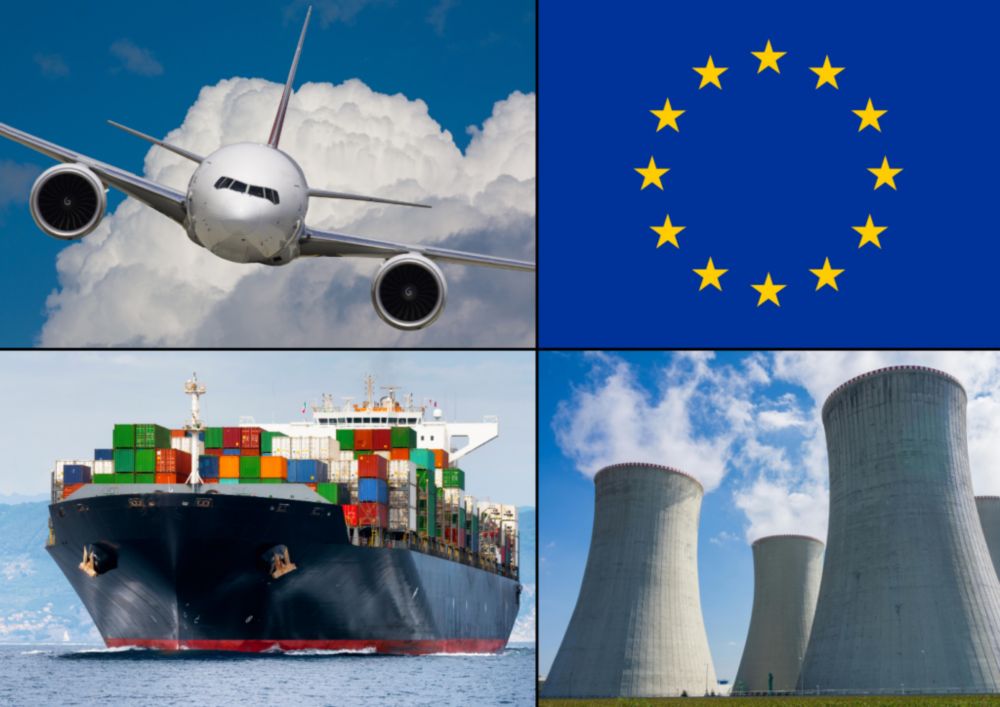
The EU ETS at a Crossroads - Sandbag
Sandbag responds to the EU ETS and Innovation Fund consultation, calling for simpler allocation rules, better-targeted innovation funding, and safeguards against weak climate solutions like CCU.
🇪🇺 The EU ETS is set to be revised – and it’s a critical opportunity to fix what’s broken.
📝 Sandbag’s response to the EU consultation:
– End free allocation
– Restrict aviation EUA access
– Link ICC to clean power
– Reform Innovation Fund
🔗 sandbag.be/2025/07/08/t...
08.07.2025 15:25 — 👍 0 🔁 0 💬 0 📌 0
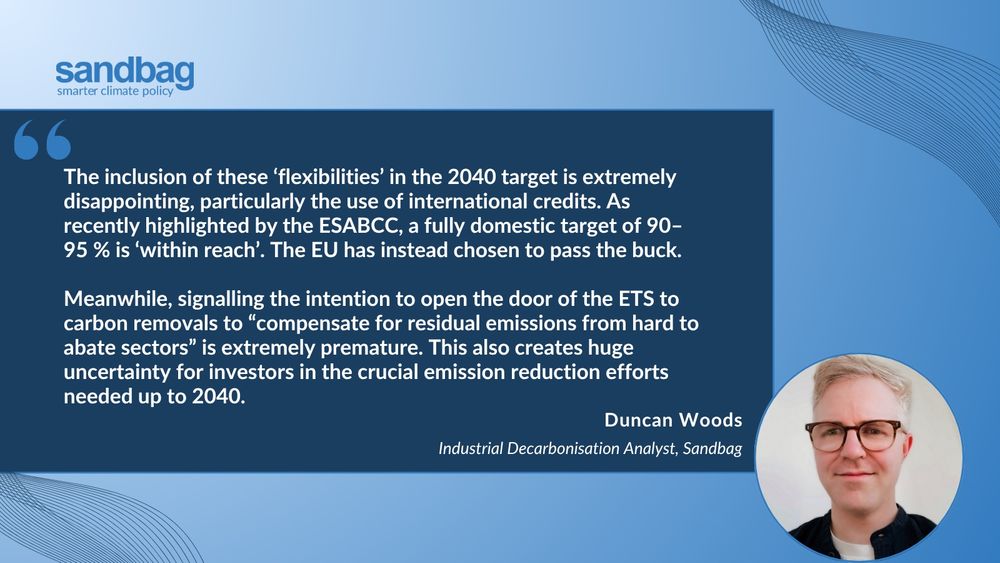
📢 The EU’s 2040 climate target relies on international credits & CDR in the ETS.
These “flexibilities” could delay crucial domestic emission reductions.
🗓️ 9 July: Sandbag's webinar explores CDR’s potential impact on ETS.
👉 Register for the webinar: lnkd.in/ezYGjDMS
#EUClimate #CarbonMarkets
02.07.2025 13:53 — 👍 0 🔁 0 💬 0 📌 0

📢 Upcoming Webinar: Simulating CDR integration in the EU ETS – Exploring the Trade-offs
SandbagClimate’s new simulator shows the risks: displaced emissions cuts & unbalanced CDR.
🛠️ Join our webinar:
🗓️ 9 July, 11:00-11:40 CEST
🔗 lnkd.in/ezYGjDMS
#EUETS #CDR #CarbonMarkets #ClimatePolicy
30.06.2025 14:59 — 👍 0 🔁 0 💬 0 📌 0
📢 Sandbag joins 30+ civil society orgs urging standards bodies to reject a “mass balance” approach promoted by Japan’s steel industry.
It would allow emissions cuts from one site to be reassigned — letting coal-based steel appear green.
🔗 tinyurl.com/47kcz43s
#Steel #Greenwashing
05.06.2025 15:46 — 👍 0 🔁 0 💬 0 📌 0
The first European affairs research network
📊 Expert Analysis/Recommendations
📺 #EuropeChats
🇪🇺 EU-funded projects
Sinn Féin Member of the European Parliament
Chair of EU Delegation on Palestine
Coordinator for The Left on Trade Committee
Member of Environment Committee
Based in Brussels, senior climate correspondent at Carbon Pulse. Won a Climate Journalism Award issued by the EJC and a Lorenzo Natali Prize. Grown up in Voxeurop, Ansa Europa, Property Week, City University London, Il Mitte etc
Energy, Environment & Transport journalist for Euractiv in Paris
stefano.porciello@euractiv.com | opinions are my own + usual disclaimers
Journalist for Contexte - Environment and EU politics nerd 🌿🤓
Énergie - climat - industrie
Avec un scope particulier sur les sujets liés à l’électrification, le stockage d'énergie, l’hydrogène, et les bioénergies.
Account for journal Environmental Politics.
Sharing our publications, website guest posts, and anything else of interest to the environmental politics community.
Website: https://environmentalpoliticsjournal.net/
Journaliste #Ecologie #Climat au @nouvelobs.com
sbillard@nouvelobs.com
A coalition of national and sub-national governments, businesses and organisations working to advance the transition from unabated coal power to clean energy.
Bloomberg journalist covering climate change, Thames Water, sewage, environment. Views mine.
Reporter at Bloomberg covering energy and climate change. Opinions are my own.
Climate, energy & trade reporter for The Parliament Magazine
The only global civil society organization that focuses on climate action on the international #shipping industry at @IMOHQ. Visit https://cleanshipping.org Also on http://cleanshipping.bsky.social
Climate journalist, Carbon Brief. Interested in energy, climate, land, food, politics, rights, critters, culture. Recovering Twitter junkie. “Sekhar” as in “shaker”.📍Mumbai, India. Views, jokes = own.
As the EU bank, we provide finance and expertise for sustainable investment projects that make a strong impact on people’s lives in Europe and beyond.
The best of FT journalism, including breaking news and analysis.
https://www.ft.com
The users this account follows are verified FT staff or contributors.
Journalism for the energy transition. We cover Europe's move to climate neutrality based on 10 years expertise with Germany's Energiewende.
www.cleanenergywire.org
Politician #MEP @europeanparliament @eppgroup @cdu_csu_ep coordinator for @ep_singlemarket #digital #competition #EUswitzerland
📍Freiburg🇩🇪 / Brüssel 🇪🇺
Associate Editor - @euractiv.com
Based in Brussels. EU politics and policy, Brexit (still), other bits
Ow(e)n views, not of employer
Journalist @euractiv.com / EU Affairs

